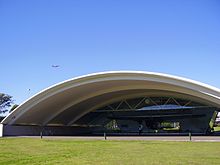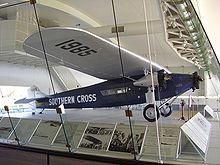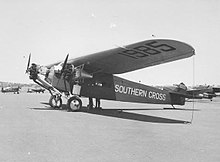Southern Cross (aircraft): Difference between revisions
Revert to revision 407646489 dated 2011-01-13 11:36:41 by Figaro — no reason to unlink perfectly good red links (see WP:REDLINKS; std image sizes; -WP:OVERLINK; +wl The Detroit News. |
|||
| Line 11: | Line 11: | ||
== Trans-Pacific flight == |
== Trans-Pacific flight == |
||
[[File:Southern Cross cockpit.jpg.jpg|thumb|''Southern Cross'' cockpit photographed in 2009.]] |
[[File:Southern Cross cockpit.jpg.jpg|thumb|''Southern Cross'' cockpit photographed in 2009.]] |
||
On May 31, 1928, the crew—Charles Kingsford Smith, Charles Ulm, and Americans |
On May 31, 1928, the crew—Charles Kingsford Smith, Charles Ulm, and Americans Harry Lyon ([[flight officer|navigator]]) and [[James Warner (aviator)|James Warner]] ([[radio operator]])<ref name=century />—took off from [[Oakland, California]], United States. The ''Southern Cross'' first stopped for rest and refueling in Hawaii before setting off for Fiji. This leg of the journey took 34 and a half hours of flight across open seas before gliding past the [[Grand Pacific Hotel (Fiji)|Grand Pacific Hotel]] in Suva, where a large and enthusiastic crowd saw the first aircraft to land in Fiji touch down at Albert Park.<ref>[http://www.fiji.embassy.gov.au/suva/MR2003smith.html 30 May 2003 – 75th Anniversary of Smithy's Landing at Albert Park]</ref> The ''Southern Cross'' landed at [[Eagle Farm Airport]] in Brisbane, Queensland, Australia, on June 9,<ref name=fff>[http://home.worldonline.nl/~lbb/smith.htm Famous Fokker Flights]</ref> where a crowd of 25,000 people were waiting to greet the ''Southern Cross'' on its arrival at the airport.<ref>[http://www.ourbrisbane.com/living/suburbs/eagle_farm/history/ History of Eagle Farm (Our Brisbane)]</ref><ref>[http://naa12.naa.gov.au/scripts/PhotoSearchItemDetail.asp?M=0&B=11363463 Photo of ''Southern Cross'', and welcoming crowd, at Eagle Farm on June 9, 1928 (National Archives of Australia)]</ref><ref>[http://www.smh.com.au/articles/2003/12/16/1071336964936.html?from=storyrhs Magnificent Machines – Home-grown Legends] ''[[The Sydney Morning Herald]]''</ref> The ''Southern Cross'' flew on to Sydney the following day (June 10). |
||
==Trans-Tasman flights== |
==Trans-Tasman flights== |
||
Revision as of 08:49, 19 April 2011

Southern Cross is the name of the Fokker F.VIIb/3m trimotor monoplane which in 1928 was flown by Australian aviator Sir Charles Kingsford Smith and his crew in the first ever trans-Pacific flight, from the mainland United States to Australia, about 7,250 miles (11,670 km).
History
The Southern Cross began life as the Detroiter, a polar exploration aircraft of the Detroit News-Wilkins Arctic expedition.[1] The aircraft had crashed in Alaska in 1926, and was recovered and repaired by the Australian expedition leader, Hubert Wilkins. Wilkins, who had decided the Fokker was too large for his Arctic explorations, met with Kingsford Smith and Charles Ulm in San Francisco and arranged to sell them the aircraft, without engines or instruments.[2]
Having fitted the aircraft out with engines and the other required parts, Kingsford Smith made two attempts at the world endurance record, in an attempt to raise funds and interest for his trans-Pacific flight. However, after the New South Wales government withdrew its sponsorship of the flight,[3] it looked as if the money would run out and Kingsford Smith would have to sell the Southern Cross. The aircraft was bought by American aviator and philanthropist Allan Hancock, who then loaned it back to Kingsford Smith and Ulm.[4]

Trans-Pacific flight
On May 31, 1928, the crew—Charles Kingsford Smith, Charles Ulm, and Americans Harry Lyon (navigator) and James Warner (radio operator)[3]—took off from Oakland, California, United States. The Southern Cross first stopped for rest and refueling in Hawaii before setting off for Fiji. This leg of the journey took 34 and a half hours of flight across open seas before gliding past the Grand Pacific Hotel in Suva, where a large and enthusiastic crowd saw the first aircraft to land in Fiji touch down at Albert Park.[5] The Southern Cross landed at Eagle Farm Airport in Brisbane, Queensland, Australia, on June 9,[6] where a crowd of 25,000 people were waiting to greet the Southern Cross on its arrival at the airport.[7][8][9] The Southern Cross flew on to Sydney the following day (June 10).
Trans-Tasman flights
Kingsford Smith and Ulm also made the first nonstop Trans-Tasman flight in the Southern Cross – over the Tasman Sea from Australia to New Zealand and back (c. 2,500 miles (4,000 km)) – beginning with the first crossing on 10/11 September 1928. Guy Menzies completed the first solo trans-Tasman flight in the Southern Cross Junior in 1931.
Preservation


Shortly before Kingsford Smith's death in 1935, he donated the Southern Cross to the Commonwealth of Australia, for display in a museum.[10] The aircraft was brought out of retirement briefly in 1945 for the filming of the movie Smithy. The Southern Cross is now preserved in a special glass hangar memorial on Airport Drive, near the International Terminal at Brisbane Airport in Queensland, Australia. There is also a full-sized flying replica of the Southern Cross in South Australia. This aircraft was built in the 1980s and is the largest replica aircraft in the world.[11]
Notes
The Southern Cross's original registration was "1985" – this number can be seen on the wings and tail of the aircraft in photos taken at the time of its first record-breaking flight. Kingsford Smith re-registered it in Australia as "G-AUSU" (4 July 1928 to 3 July 1929), and then VH-USU (5 April 1931 – ).[10] The "1985" marks and original colour scheme were restored when the plane went on public display.
The Southern Cross was named after the Southern Cross Constellation, a popular symbol of the Southern Hemisphere in general and Australia in particular. Kingsford Smith continued the theme with his later aircraft Southern Cross Minor and Southern Cross Junior (both Avro Avians), Miss Southern Cross (Percival Gull), and Lady Southern Cross (Lockheed Altair). He also produced a car with the name, and gave the aircraft operated by his airline, Australian National Airways, similar names beginning with Southern.
In September 2010, the Old Gateway Motorway, which runs past the site of the original Eagle Farm Airport, was renamed Southern Cross Way.[12]
References

- ^ Carl "Ben" Eielson, NAHF (Pilot of the Detroiter)
- ^ Ace Pilots
- ^ a b Century of Flight
- ^ "Smithy" and the Southern Cross, State Library of NSW
- ^ 30 May 2003 – 75th Anniversary of Smithy's Landing at Albert Park
- ^ Famous Fokker Flights
- ^ History of Eagle Farm (Our Brisbane)
- ^ Photo of Southern Cross, and welcoming crowd, at Eagle Farm on June 9, 1928 (National Archives of Australia)
- ^ Magnificent Machines – Home-grown Legends The Sydney Morning Herald
- ^ a b ADF Serials
- ^ Southern Cross replica
- ^ Gateway renamed the Southern Cross Way, The Sydney Morning Herald
